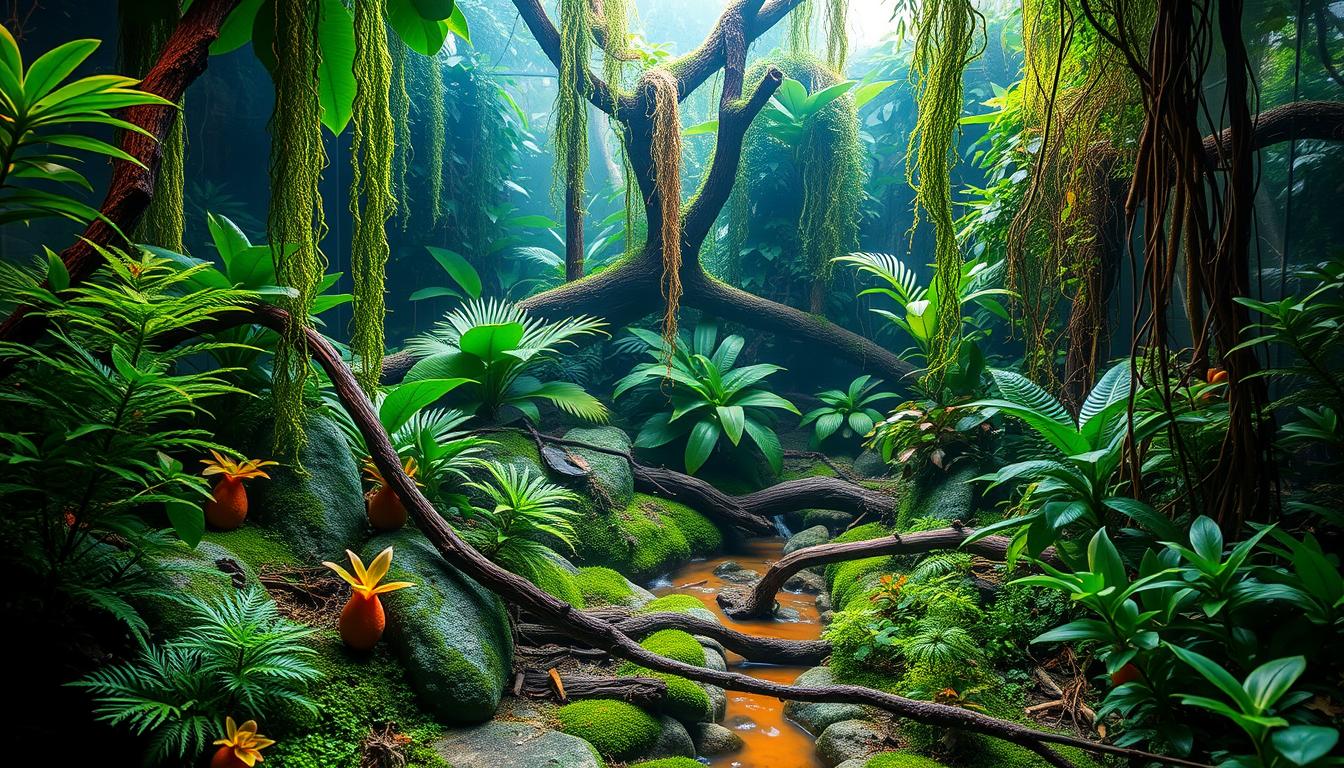Creating a Rainforest Vivarium for Dart Frogs
Can a miniature rainforest be created in a glass enclosure to provide a healthy habitat for dart frogs? The answer lies in understanding the specific needs of these amphibians and replicating their natural environment. Dart frogs require a humid and temperate environment with abundant plant life. A well-designed vivarium can provide the perfect conditions for…
Can a miniature rainforest be created in a glass enclosure to provide a healthy habitat for dart frogs? The answer lies in understanding the specific needs of these amphibians and replicating their natural environment.
Dart frogs require a humid and temperate environment with abundant plant life. A well-designed vivarium can provide the perfect conditions for these frogs to thrive.
By mimicking their native habitat, you can create a self-sustaining ecosystem that benefits both the frogs and the plants. This comprehensive guide will walk you through the process of creating a bioactive rainforest vivarium.
Key Takeaways
- Understand the environmental needs of dart frogs
- Replicate their natural habitat in a vivarium
- Maintain proper humidity and temperature levels
- Create a self-sustaining ecosystem
- Choose the right plants for your vivarium
Understanding Rainforest Vivariums for Dart Frogs
Creating a suitable environment for dart frogs requires a deep understanding of their natural habitat and the specific conditions they need to thrive. A vivarium is a specially designed enclosure that replicates the natural environment of these frogs, providing them with the necessary conditions to live and breed.
What Is a Vivarium and Why Dart Frogs Need One
A vivarium is more than just a terrarium; it’s a complete ecosystem that includes plants, substrate layers, and beneficial microorganisms working together to create a balanced environment. Dart frogs need a vivarium because it provides them with the specific conditions they require, such as high humidity (80-90%), moderate temperatures (70-75°F), and proper air circulation. As“Dart frogs are terrestrial species that live on the rainforest floor”, they require a habitat that mimics their natural environment.
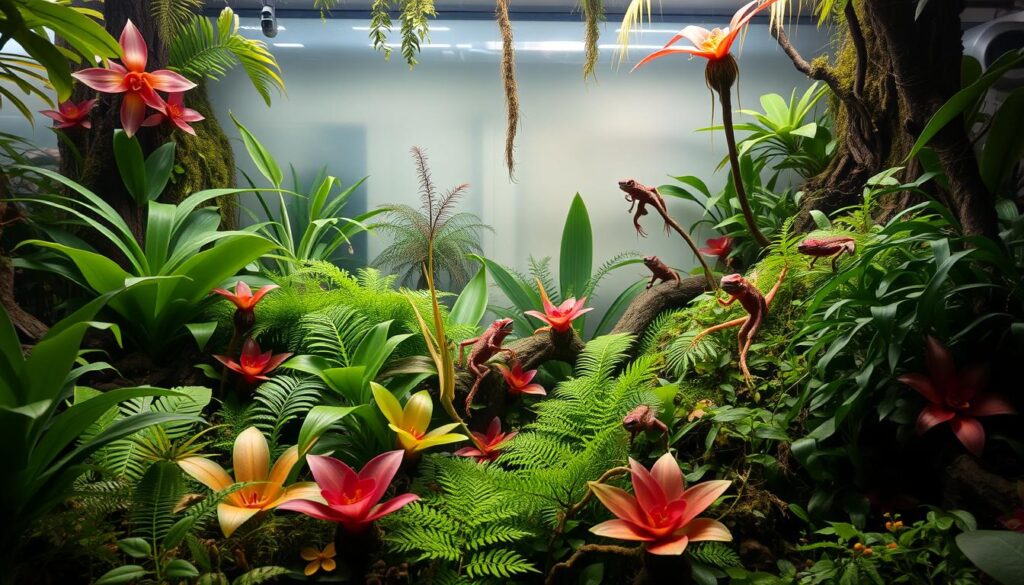
Essential Environmental Parameters
To keep dart frogs healthy, it’s crucial to maintain the right environmental parameters. The vivarium’s glass enclosure helps maintain humidity levels while providing proper ventilation to prevent stagnant air and excessive condensation. The key parameters to monitor include temperature gradients, humidity levels, ventilation, and lighting cycles that support both plant growth and frog activity patterns. As dart frogs are sensitive to chemicals and toxins, water quality and material selection are also crucial considerations in vivarium design. By understanding and controlling these parameters, you can create a thriving environment for your dart frogs.
Setting Up the Foundation Layers
Establishing a thriving dart frog vivarium begins with setting up the right foundation layers. These layers are crucial for maintaining a healthy environment for your frogs, ensuring proper humidity, and preventing issues such as soil saturation and stagnation.
Drainage Layer Options and Installation
A well-designed drainage layer is essential for the health of your dart frogs. This layer, typically composed of clay balls or Hydroton, provides a reservoir for excess water and a habitat for beneficial bacteria to break down waste. To enhance drainage, consider incorporating a drain pipe to periodically empty the reservoir, preventing water buildup. A “false bottom” can be created using egg crate material topped with a screen, allowing for a taller drainage layer.
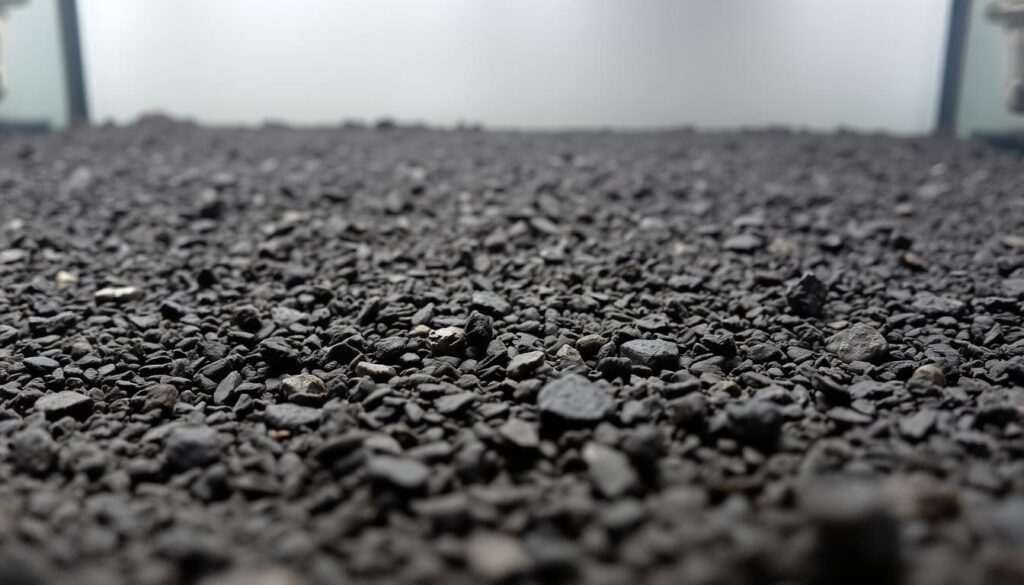
Separator Layer Construction
The separator layer, usually made from a fiberglass screen or weed barrier fabric, is placed above the drainage layer. Its primary function is to prevent the substrate from washing into the drainage layer while allowing water to pass through freely. This layer is crucial for maintaining the integrity of both the drainage layer and the substrate.
Substrate Selection and Preparation
Selecting the right substrate is vital for the health of your dart frogs and the overall ecosystem of the vivarium. The ABG mix, a blend of tree fern fiber, orchid bark, peat moss, charcoal, and sphagnum moss, is highly recommended. It’s essential to avoid substrates containing fertilizers, perlite, or manure, as these can be harmful to sensitive amphibians.
Top Layer and Leaf Litter Importance
The top layer of leaf litter plays a multifaceted role in the vivarium. It provides hiding places for the frogs, helps maintain moisture levels, creates foraging opportunities, and supplies food for the cleanup crew. Sterilized magnolia or live oak leaves are ideal due to their slow decomposition rate and durability in humid environments.
Creating Natural Backgrounds and Decorations
A well-designed background is crucial for creating a naturalistic environment in a dart frog vivarium. It not only enhances the aesthetic appeal but also provides additional climbing surfaces and security for the frogs.
Background Construction Methods
There are several methods to construct a background for a vivarium. One common approach is using a single piece of cork bark cut to fit the back of the enclosure. Alternatively, expanding spray foam, such as Great Stuff Pond and Waterfall, can be used to create more complex structures. This foam can be sculpted and covered with coconut fiber to achieve a natural look. When using expanding foam, it’s essential to ensure it’s fully cured before carving and sealing with aquarium-safe silicone to prevent gaps where frogs might become trapped.
Safe Wood and Decor Selection
Selecting the right wood for decorations is critical, as some types can be toxic to amphibians. Safe options include cork bark, Ghostwood, Malaysian Driftwood, and Mopani wood, which are moisture-tolerant and less prone to rot. It’s advisable to avoid using pine, cedar, and eucalyptus, as they contain oils and resins harmful to dart frogs.
| Safe Wood Options | Characteristics |
|---|---|
| Cork Bark | Moisture-tolerant, durable |
| Ghostwood | Resistant to rot, visually appealing |
| Malaysian Driftwood | Unique shapes, durable |
| Mopani Wood | Hardy, resistant to moisture |
Plant Placement and Mounting
Strategic plant placement is vital for creating microclimates within the vivarium, providing varied humidity levels and natural hiding spots for frogs. Epiphytic plants like bromeliads can be mounted directly to backgrounds or hardscape using fishing line or aquarium-safe silicone. When planning the layout, consider the mature size and growth habits of plants to prevent overcrowding and maintain proper air circulation.
By carefully selecting and placing plants, wood, and other decorations, you can create a thriving and visually appealing environment for your dart frogs.
Vivarium Housing and Technical Setup
The right vivarium housing and technical setup are essential for maintaining a thriving environment for dart frogs. A well-designed vivarium provides the necessary conditions for both the frogs and the plants to flourish.
Choosing the Right Enclosure Size and Type
Selecting the appropriate vivarium size is crucial for dart frog health. A minimum of 10 gallons is recommended for a single frog, with an additional 5 gallons for each additional frog. However, larger enclosures (24-36 inches in length) provide better environmental stability. Front-opening terrariums from manufacturers like ZooMed and Exo-Terra offer easier access for maintenance and feeding.
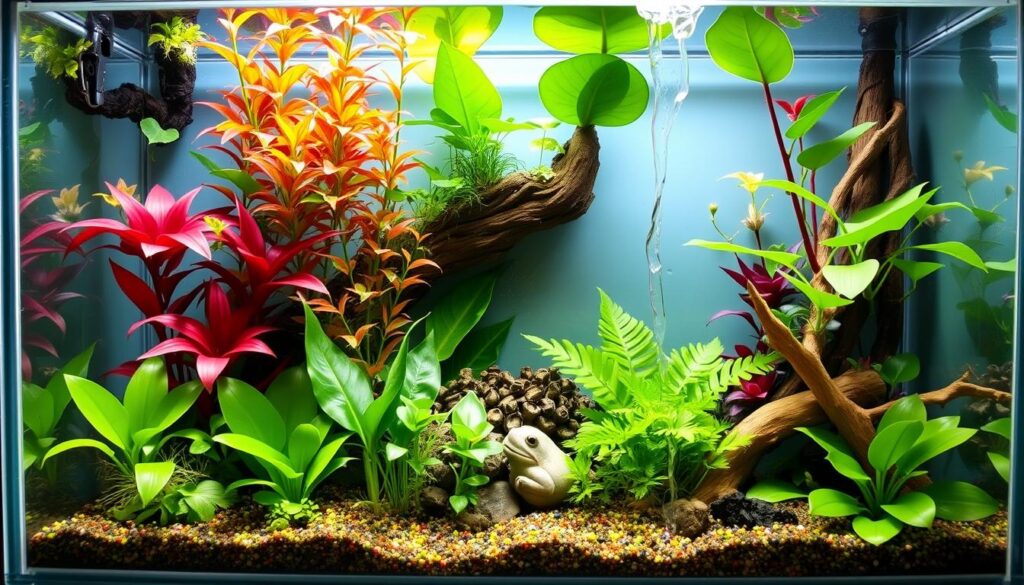
Glass Top Modification for Humidity Control
Modifying the standard screen top with a glass cover is essential for maintaining proper humidity levels. Strategic ventilation holes or strips can prevent excessive condensation. Creating a custom glass top with a hinged front section facilitates easy access while maintaining humidity.
Lighting Requirements for Plants and Frogs
Proper lighting serves primarily to support plant growth rather than for the frogs themselves. A 6500K full-spectrum LED fixture provides ideal light without generating excessive heat. This type of lighting is suitable for promoting healthy plant growth in the vivarium.
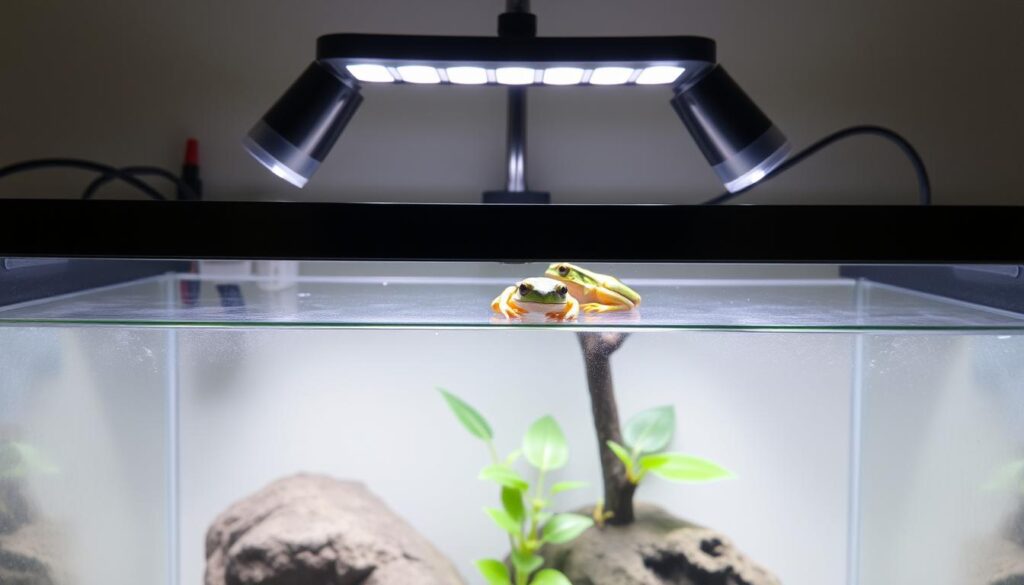
Temperature and Humidity Monitoring
Temperature monitoring is critical as dart frogs are heat-sensitive. Ideal temperatures range from 70-75°F, and temperatures above 80°F should be avoided. Digital hygrometers and thermometers should be placed at different heights within the vivarium to monitor environmental conditions throughout the enclosure.
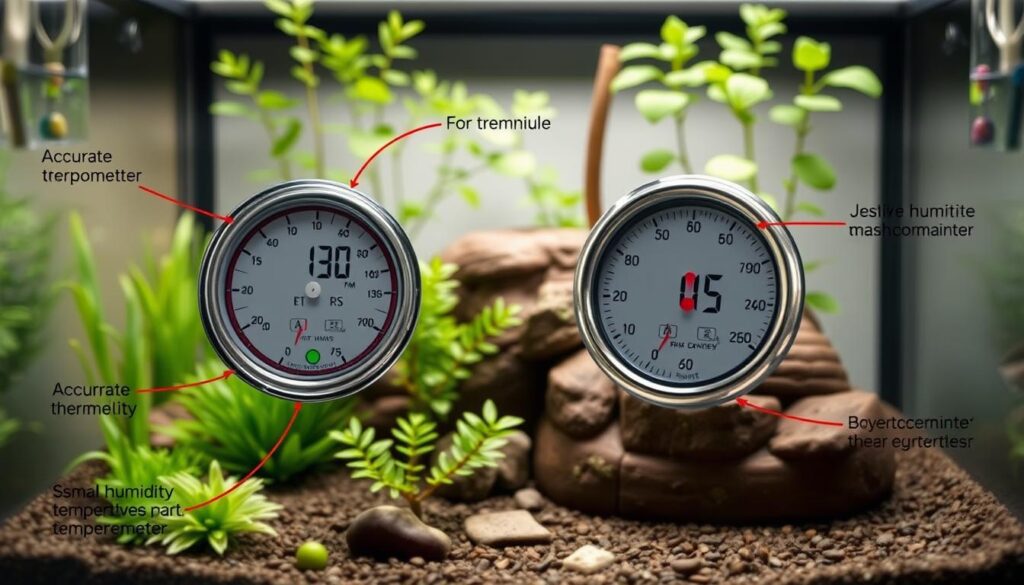
Water Management and Bioactive Elements
Water management and bioactive elements are key to a sustainable and healthy dart frog vivarium. Effective water management ensures the well-being of the frogs and the overall ecosystem within the vivarium.
Proper Water Sources and Misting Techniques
Using the right water source is crucial for the health of your frogs. Tap water contains chemicals like chlorine and chloramine that can harm your frogs. Instead, use distilled or reverse osmosis (RO) water to avoid these contaminants.
Regular misting is essential to maintain humidity levels and provide drinking water for your frogs, who absorb moisture through their skin.
Avoiding Standing Water Hazards
Dart frogs are terrestrial and poor swimmers. Therefore, it’s crucial to minimize or eliminate standing water in their enclosure to prevent drowning risks.
Avoid using water features like waterfalls or streams that can create more problems than benefits, including bacterial growth and drowning hazards.
Establishing a Bioactive Cleanup Crew
A bioactive cleanup crew consisting of springtails and isopods helps break down waste, control mold, and convert organic matter into plant nutrients.
Leaf litter provides both habitat and food for the cleanup crew, creating a natural cycle where waste is processed and nutrients are recycled within the vivarium.
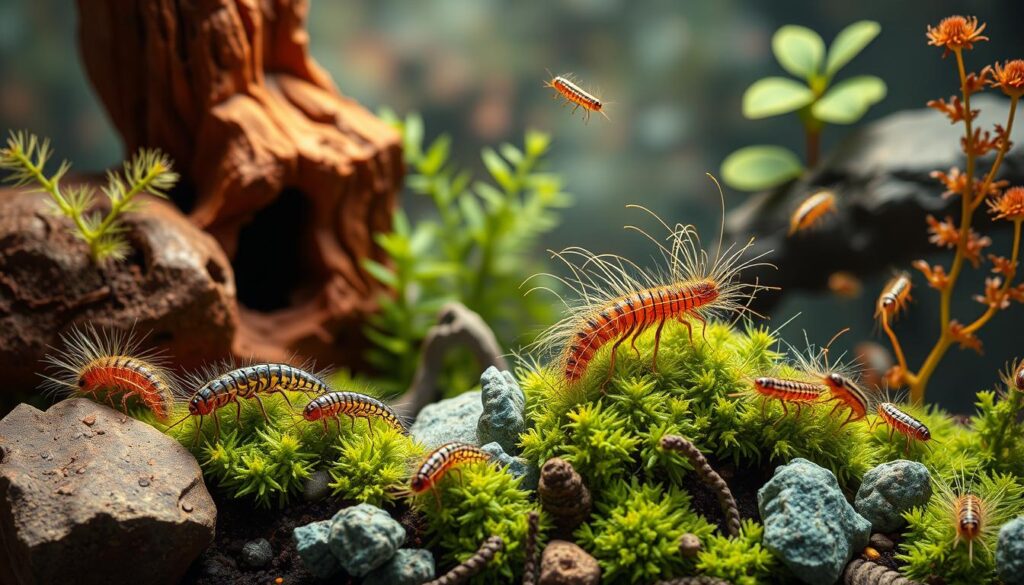
Conclusion
The art of crafting a rainforest vivarium for dart frogs involves a deep understanding of these amphibians’ needs and the creation of a self-sustaining ecosystem. A well-designed vivarium provides a unique opportunity to showcase frogs in a naturalistic environment.
To achieve success, it’s essential to allow the viv to “cycle” for several weeks to a month before introducing dart frogs, enabling plants to root and the cleanup crew to establish. Regular monitoring of water levels, temperature, and humidity is crucial for maintaining optimal conditions.
The bioactive approach reduces long-term maintenance requirements while providing a healthier environment for dart frogs to thrive. With proper setup and care, your rainforest vivarium will develop into a balanced ecosystem where plants, microorganisms, and frogs coexist in harmony.

